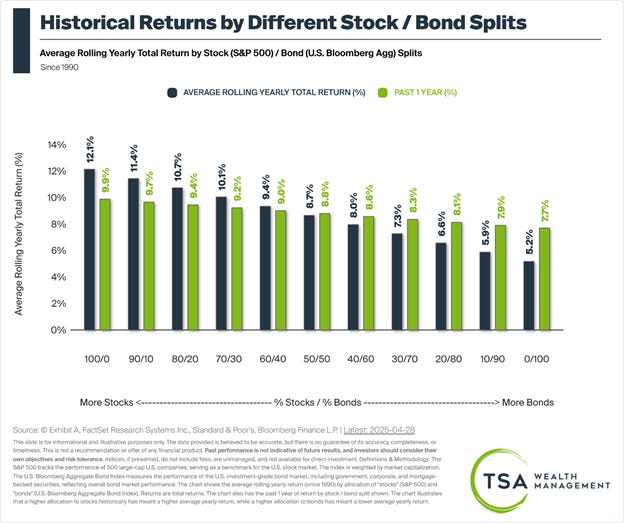Bonds Alone Aren't Enough
When the headlines get scary and the stock market gets volatile, I’ll hear investors say things like, “If I can get 4 or 5% from bonds, why should I own stocks at all?”
Ignoring that the world is always scary and the future is always unknown, the following charts explain why a 100% bond allocation is rarely the correct answer for retirees.
1) Bonds Typically Generate Lower Returns
In the chart below, the blue bars represent the average return since 1990, and the green bars represent the return over the last 12 months (through April 28th). Historically, the higher the bond allocation, the lower an investor’s average return.
Nervous investors like to argue that bonds have less risk than stocks. And that is true if short-term volatility is used as a proxy for risk. However, if you define risk as the likelihood of running out of money over a multi-decade retirement, bonds have arguably been much riskier than stocks.
2) Stocks Can Hedge Potential Bond Losses
While it is generally true that a 5% bond will yield 5% per year if it is held to maturity and doesn’t default, its price can fluctuate at any given moment based on changes in interest rates or credit spreads. This is how bond investors earning a fixed rate of return can see their statement values decline from one year to the next.
That is where the following “Win-Ratio” chart comes in. The “Win-Ratio” represents the percentage of positive rolling yearly returns for various stock-to-bond splits.
The 100% bond allocation achieved positive yearly returns 85% of the time, whereas the 20% stock/80% bond allocation was positive 91.3% of the time. Since 1990, adding a ten to fifty percent allocation to stocks has not only increased the likely return (as shown in the first chart) but also increased the likelihood of the portfolio having a positive return in any given year.
Finding Your Balance
This isn’t to say bonds never make sense. The money you plan on using in the next two years should never be in the stock market, and if the thought of a decade-long stock decline keeps you up at night, increasing your bond and cash position to ten years of spending may be the right thing to do.
But don’t overdo it.
Just because something is less volatile in the short run doesn’t necessarily mean it is safer in the long run.
Personal note:
Last weekend, my wife and I had fun raising money for Hunt With Heart at their annual Gala. The organization’s mission is to empower and enhance the lives of children with severe illnesses through unforgettable outdoor experiences.



Pictured along with my wife and me are my brother-in-law, my sister-in-law, Austin (my business partner at TSA Wealth Management), and his wife. A great time was had by all.





When it comes to writing about investments, the disclaimers are important. Past performance is not indicative of future returns, my opinions are not necessarily those of TSA Wealth Management, an SEC-registered investment advisor, and this is not intended to be personalized legal, accounting, or tax advice etc.
For additional disclaimers associated with TSA Wealth Management please visit https://tsawm.com/disclosure or find TSA Wealth Management's Form CRS at https://adviserinfo.sec.gov/firm/summary/323123